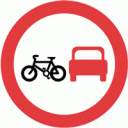Road hog theory: why are Spanish drivers in the Canary Islands so polite towards cyclists?
People are often suprised at the respect drivers have for cyclists while riding in Tenerife. They’ll move completely over to the other side of the road when overtaking; if there isn’t at least 1.5m of extra space, they patiently wait until its safe to do so. You never get beeped just because you are a cyclist -even on single lane roads without a cycle lane! Why is this so?
We all know that in Australia, the UK and USA, things are very different indeed. Its as if motorists resent the very presence of cyclists. I have cycled here in Tenerife for 2 years and I’m yet to see an angry motorist. After observing the local Spanish driving culture in general, I believe I can speculate about why this is so:
Firstly, there’s a notoriously difficult theory test, even for native spanish speakers. The average student sits in class for some 10-20 hours before they are able to pass!! All aspects of road theory are drummed into students from the beginning. They are told that anything with more than two wheels is considered a VEHICLE. There are many many references to situations involving cyclists. In total, our instructor must have lectured about the safety of overtaking bikes for probably an hour or so. I’m actually currently enduring many Spanish driving lessons, and since then, the pieces are all falling into place.
There are several important points regarding cyclists that drivers are forced to assimilate:
- First and foremost, bikes are treated like all other vehicles with two wheels, and cars must give way as they normally would. Vehicles with two wheels are considered «more at risk to injury», so there are special rules pertaining to them.
- Cyclists are obliged to travel in bicycle lanes or breakdown lanes wherever possible. Special rules apply when cyclists are forced to share the road with other traffic. These road rules are outlined below.Â
- On a single lane road, vehicles CANNOT pass a cyclist travelling in the same lane unless they do so safely. Outside metropolitan areas, on any road, the safe overtaking distance is stipulated as greater than 1.5m separation. Within populated / metropolitan streets, the seperation distance depends on both the width of the road and the conditions - but the main point to bear in mind is that vehicles must moderate their velocity considerably to a safe level. This could mean speeds as low as 40, 30, 20 or even 10km/hr, depending on the circumstances, as some of the streets in older Spanish towns can be very narrow indeed.
- Providing there is no oncoming traffic & sufficient visibility, drivers ARE permitted to cross a single white line to overtake a single cyclist. In fact it’s compulsory!!! If a vehicle, fails to move either completely or partially into that oncoming lane, and a civil guard officer catches a motorist doing that, they risk a hefty €1500 fine!! This is a relatively recent rule. It was changed because a few years ago, two promising young spanish cyclists were killed in a single weekend (they were said to be like the next «Indurain»). So now the traffic authority says, «OK you can overtake a cyclist if they’re going too slow, but YOU must put your life on the line.» This road rule is in direct contrast to that of Australia, where drifting over a double yellow line is strictly forbidden. This is possibly the best spanish road rule of all as far as solo cylists are concerned. I’ve never been sidewiped here. NEVER. In several other parts of the world, you literally put your life at risk everytime you go out riding on a single lane road.
- Furthermore, contrary to the rule #4, it’s not permitted to overtake a group of cyclists on a single lane road, unless there is a discontinuous line which allows the overtaking manoeuvre to be made safely, respecting the minimum separation distance of 1.5 metres. If there is a continuos white line, all drivers just have to lump it and wait until it is safe to overtake. (Although having said that, cyclists and motorists have a secret pact: we get out of their way as soon as we can & we never hold them up on purpose, and in return, they respect our our right to use a bicycle on a public road and the all-important safety margin).
- A group of cyclists is defined as «2 or more riders travelling together». They’re considered a single unit, like a singular vehicle as it were. So if one cyclist with the right of way has already entered an intersection, other vehicles must give way to the entire group (whether there’s 3 travelling in a straight line, or 500 in a bunch).
- Cycling two abreast is permitted providing you aren’t impeding the flow of traffic.
- Another general rule is that cars cannot overtake cyclists on long windy descents.
Apart from the points mentioned above, cyclists in Europe generally command greater respect, as it’s more a part of the culture. Riding up, you hear people cheering at you «Venga! Venga! Venga!» (C’Mon! C’Mon! C’Mon!) Maybe they think you’re a pro training for the Vuelta de España! Who knows? But nobody ever gets mad unless you ride on the freeway (which is stricty forbidden). In Spain, bicycles are permitted on autovÃas, but not autopistas; in case you were wondering, TF1, TF2 and TF5 are all autopistas.
The other thing about Tenerife in particular is that it is a large volcanic island. Perhaps when younger, drivers tried to ride around on their little bikes, realised how difficult it was, and remembered the feeling forever after. So it’s as if the act of being forced to cycle 100% hills all the time gives you more credit amongst the locals.
Having said all that about cyclists, motorists have considerably less respect for pedestrians, so watch your step when crossing any road! This falls somewhere into the «pedestrians are not considered vehicles»Â loophole. In Australia, if you happen to be standing or hovering within a 10 metre proximity of a zebra crossing, all cars will feel obliged to stop. Here, you can be standing at the edge, and 10 cars shoot straight through as though you’re invisible.



Hi there,
I just found your blog, and you’ve written some great posts. I’ll have to make sure I check in more often.
In answer to this post, I ride in Queensland, where drivers are bad even by Australian standards — I’ve reached the point where my response to being hit by a car is just to keep riding without even looking up. I really think a lot of it has to do with law enforcement, or the lack of. Even London peak-hour is easy by comparison.
Much the same laws exist here as appears to be the case in Tenerife, yet here people know that if the break the law, there’s a 99% chance they’ll get away with it. Consequently, a lot of drivers here have a «because I can» mentality, which seems to be along the lines of «I have 2 tonnes of steel behind me so you better get out of my way or I’ll run you down».
That said, one thing I noticed in London was that people generally don’t make such a big deal out of the simple act of riding a bike the way they seem to in Australia, and I actually think the people who call themselves ‘cycling advocates’ in this country are largely responsible for that.